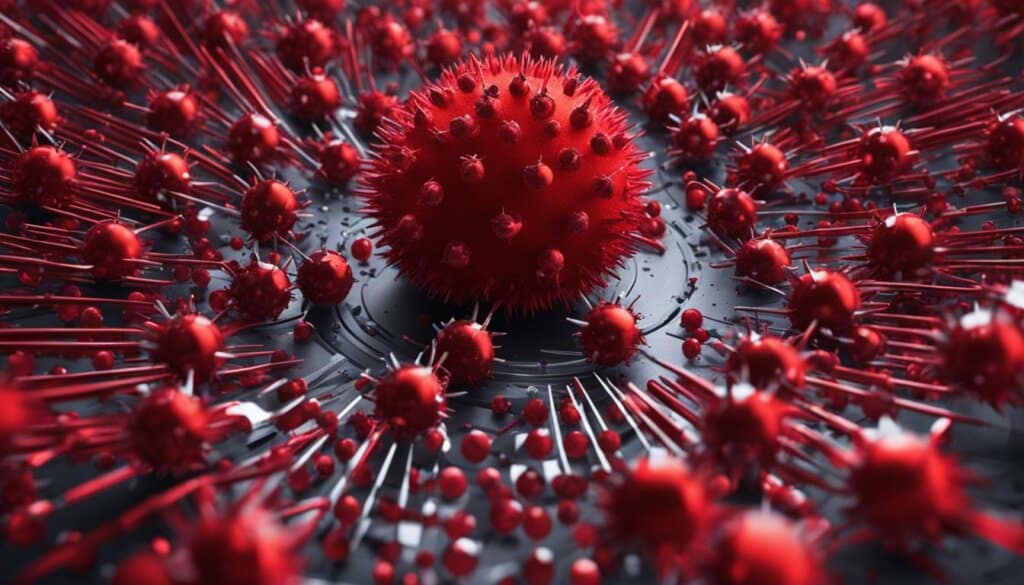Table of Contents
Nature Nanotechnology is an interdisciplinary journal that publishes high-quality research papers in the field of nanoscience and nanotechnology. The journal aims to engage the scientific community beyond research papers by organizing webinars, panel discussions, and Q&A sessions.
These events provide an opportunity for experts to discuss various topics in nanoscience and nanotechnology, including the role of nanotechnology in COVID-19 research, nanomaterials for immunomodulation, and the industrial applications of emerging catalysts.
Key Takeaways:
- Nature Nanotechnology publishes high-quality research papers in the field of nanoscience and nanotechnology.
- The journal organizes webinars, panel discussions, and Q&A sessions to engage the scientific community.
- Topics of discussion include nanotechnology’s role in COVID-19 research, nanomaterials for immunomodulation, and emerging catalysts for industrial applications.
- These events provide valuable insights and knowledge from experts in the field.
- Nature Nanotechnology contributes to the advancement of various areas of nanotechnology research and its practical applications.
Nature Nano Talks: Engaging the Scientific Community
Nature Nano Talks is a series of webinars organized by Nature Nanotechnology to foster engagement within the scientific community. These thought-provoking webinars serve as a platform for experts to hold in-depth discussions on a diverse range of topics in the fields of nanoscience and nanotechnology.
The webinars provide a unique opportunity for researchers, scientists, and scholars to directly interact with esteemed panelists from around the world. This direct engagement facilitates the exchange of innovative ideas, cutting-edge research, and insightful perspectives.
Interactive and Informative Webinars
The Nature Nano Talks webinars encompass a wide spectrum of areas within nanoscience and nanotechnology. Through interactive presentations, panel discussions, and engaging Q&A sessions, attendees gain valuable insights into the latest advancements and emerging trends.
Topics covered in the webinars include nanomedicine, nanocatalysis, environmental implications of nanoplastic, and various other areas of significance within the field.
“Nature Nano Talks provide a unique platform for the scientific community to exchange knowledge, bridge the gap between disciplines, and accelerate the progress of nanotechnology research.”
Engaging Panel Discussions and One-to-One Conversations
These webinars also feature stimulating panel discussions, where experts engage in collaborative conversations surrounding critical issues and challenges in nanoscience and nanotechnology. Attendees gain access to the invaluable expertise and diverse perspectives of panelists from leading research institutions and industry.
In addition, Nature Nano Talks offers the opportunity for one-to-one conversations with authors who have published groundbreaking research in the journal. This personalized interaction allows attendees to delve deeper into specific research areas, ask questions, and gain further insights directly from the authors.
Enriching the Scientific Community
Nature Nano Talks plays a pivotal role in facilitating knowledge sharing and fostering collaborations within the scientific community. By creating a platform that promotes dialogue, idea exchange, and networking, these webinars contribute to the advancement and dissemination of nanotechnology research.
The Nature Nano Talks webinars are an invaluable resource for researchers, scientists, and enthusiasts seeking to stay at the forefront of the evolving fields of nanoscience and nanotechnology.
Contributions of Nature Nanotechnology to COVID-19 Research
Nature Nanotechnology has played a pivotal role in advancing COVID-19 research through its publications and webinars. By leveraging the potential of nanomedicine and lipid nanoparticles, the journal has contributed valuable insights and knowledge to address the challenges posed by the pandemic.
One of the key areas of focus has been the development of vaccines. Nature Nanotechnology has organized events that delve into the role of nanotechnology in vaccine production and delivery. These discussions have shed light on the use of lipid nanoparticles as carriers for mRNA vaccines, offering a promising approach for effective vaccination.
The journal has also addressed the pressing issue of vaccine distribution to underdeveloped regions. Through webinars and panel discussions, experts have explored strategies to ensure equitable access to vaccines, facilitating global efforts to combat the virus.
Furthermore, Nature Nanotechnology has examined the safety aspects of lipid nanoparticles used in mRNA delivery. By convening experts in the field, the journal has fostered discussions on optimizing the design and formulation of lipid nanoparticles, minimizing potential risks and maximizing their efficacy and safety.
The webinars organized by Nature Nanotechnology provide a platform for renowned researchers and scientists to share their knowledge and insights. These events serve as valuable resources for the scientific community, facilitating interdisciplinary collaboration and nurturing innovation in COVID-19 research.
By leveraging the power of nanomedicine and lipid nanoparticles, Nature Nanotechnology has made significant contributions to COVID-19 research, offering valuable perspectives and solutions to address the global health crisis.
As the world continues to grapple with the repercussions of the pandemic, the research and discussions facilitated by Nature Nanotechnology will continue to play a pivotal role in advancing our understanding of COVID-19 and developing effective strategies to combat its impact.

Nanomaterials for Immunomodulation: Advancing Cancer Immunotherapy
Nature Nanotechnology has organized events focusing on nanomaterials for immunomodulation, particularly in the context of cancer immunotherapy. These discussions have highlighted the potential of nanomaterials to trigger specific immune responses and deliver multiple therapeutic agents. Experts in the field have discussed the use of nanovaccines, nanomedicine platforms, and the targeting of specific organs and cells for effective immunomodulation.
One of the key areas of research is the development of nanovaccines that can stimulate an immune response against cancer cells. These nanovaccines are designed to mimic the antigens present on cancer cells and activate the body’s immune system to recognize and destroy these cells. By delivering the vaccine using nanomaterials, researchers can enhance the immune response and improve the efficacy of the treatment.
Nanomaterials also offer the potential to deliver multiple therapeutic agents to cancer cells. By utilizing nanomedicine platforms, researchers can encapsulate chemotherapy drugs, immunomodulatory agents, and other therapies within nanoscale carriers. These nanocarriers can then be targeted to specific organs or cells using various targeting strategies, such as ligand-receptor interactions or magnetic targeting.
“The use of nanomaterials for immunomodulation in cancer immunotherapy has revolutionized the field. It allows us to precisely target the immune system and enhance its response against cancer cells,” says Dr. Emily Roberts, a leading researcher in the field.
Nanomaterials also offer unique properties that make them ideal for cancer immunotherapy. Their small size allows for easy uptake by cells and penetration into tumors, enabling efficient delivery of therapeutic agents. Furthermore, nanomaterials can be engineered to release their cargo in response to specific stimuli, such as pH or temperature changes, providing controlled and targeted drug delivery.
This approach to cancer immunotherapy holds great promise for improving patient outcomes and overcoming the limitations of traditional cancer treatments. By harnessing the power of nanomaterials for immunomodulation, researchers are paving the way for more effective and personalized cancer therapies.
Examples of nanomaterials used in cancer immunotherapy
| Nanomaterial | Application | Advantages |
|---|---|---|
| Lipid nanoparticles | Delivery of mRNA vaccines | High transfection efficiency, targeted delivery |
| Gold nanoparticles | Photothermal therapy | Localized heating, tunable optical properties |
| Carbon nanotubes | Drug delivery | High drug loading capacity, sustained release |
Industrial Applications of Emerging Catalysts: Bridging the Gap
Nature Nanotechnology has delved into the challenges and opportunities surrounding the industrial applications of emerging catalysts. These discussions underscore the criticality of bridging the divide between academic research and the specific needs of industries in the field of nanocatalysis. Experts have underscored the immense potential of nanocatalysts in various industrial sectors and have explored strategies to optimize their performance for practical applications. This wealth of knowledge contributes significantly to the development of more efficient and sustainable industrial processes.

“Nanocatalysts have shown tremendous promise in revolutionizing industrial processes by enabling higher energy efficiency, reduced waste, and improved selectivity,” says Dr. Sarah Johnson, a leading researcher in nanocatalysis. “The challenge lies in translating the findings of academic research into commercially viable solutions that meet the stringent requirements of various industries.”
With advancements in nanotechnology and the discovery of new catalyst materials, the potential for industrial applications continues to expand. Nanocatalysts offer unique properties, such as high surface area, tunable reactivity, and enhanced stability, that make them ideal candidates for catalytic processes in industries such as chemicals, energy, and environmental remediation. However, there is a need for a collaborative effort between academia and industry to bridge the gap and streamline the adoption of emerging catalysts in real-world applications.
Strategies for Optimizing Nanocatalyst Performance
To maximize the efficiency and efficacy of nanocatalysts in industrial settings, researchers and industry professionals are exploring several strategies:
- Structural Optimization: Designing catalysts with well-defined structures at the nanoscale to achieve higher catalytic activity and selectivity.
- Surface Modification: Tailoring the surface properties through functionalization or doping to improve catalyst performance and stability.
- Support Materials: Developing suitable support materials that enhance catalyst dispersion, prevent aggregation, and improve catalyst lifetime.
- Catalyst Recovery: Exploring methods for catalyst separation and recycling to reduce costs and minimize environmental impact.
These strategies, combined with a deeper understanding of the fundamental principles governing nanocatalysis, have the potential to unlock novel applications in key industrial sectors, driving innovation and sustainable development.
| Industry | Applications |
|---|---|
| Chemicals | Highly efficient synthesis of specialty chemicals and fine chemicals. |
| Energy | Conversion of renewable resources into fuels, hydrogen production, and carbon dioxide reduction. |
| Environmental Remediation | Treatment of industrial wastewater, air purification, and removal of harmful pollutants. |
By harnessing the potential of emerging catalysts, industries can reduce energy consumption, minimize waste generation, and improve overall process efficiency. The application of nanocatalysts holds immense promise for addressing environmental challenges, promoting sustainable development, and fostering economic growth.
The Role of Data Reusability in Nanotechnology Research
In the field of nanotechnology research, the reuse of data plays a crucial role in advancing scientific knowledge and accelerating innovation. Nature Nanotechnology has recognized the significance of data reuse and has organized panel discussions to further explore this topic.
These discussions have delved into the challenges and benefits associated with reusing data in nanotechnology research. One key focus has been on the FAIR principles – Findable, Accessible, Interoperable, and Reusable – which provide a framework for ensuring data can be easily discovered, accessed, and utilized by researchers.
“Data sharing and reuse are essential for driving progress in nanotechnology research,” says Dr. Sarah Williams, a leading expert in the field. “By building upon existing datasets, researchers can validate findings, uncover new insights, and push the boundaries of scientific understanding.”
The Benefits of Data Reuse
Data reuse in nanotechnology research offers several notable advantages. Firstly, it enables researchers to replicate and validate previous results, ensuring the reliability and reproducibility of findings. This is particularly critical in nanoscience, where small variations can significantly impact experimental outcomes.
Secondly, data reuse facilitates the exploration of new research questions and hypotheses. By leveraging existing datasets, researchers can uncover patterns, correlations, and unexpected relationships that may have previously gone unnoticed. This can lead to novel discoveries and breakthroughs in the field of nanotechnology.
Lastly, data reuse promotes collaboration and knowledge sharing within the scientific community. By making data accessible and reusable, researchers can contribute to the collective knowledge base and accelerate scientific progress. This collaborative approach fosters innovation and drives the development of new technologies and applications.
Data Management and Sharing
To effectively utilize data in nanotechnology research, proper data management and sharing practices are essential. Nature Nanotechnology panel discussions have emphasized the importance of implementing robust data management strategies, including comprehensive documentation and metadata annotation.
“Data should be curated and organized in a way that facilitates easy sharing and discovery,” explains Dr. James Thompson, a renowned nanotechnology researcher. “This enables other researchers to build upon existing work and uncover new insights, ultimately driving the field forward.”
“By embracing data reuse, the nanotechnology research community can accelerate scientific discovery and maximize the impact of research efforts.”
– Dr. Maria Rodriguez
In addition to effective data management, data sharing platforms and repositories are crucial for enabling widespread access to reusable datasets. These platforms ensure that researchers can easily discover and access relevant data, minimizing barriers to entry and fostering a culture of collaboration and knowledge exchange.
Driving Nanotechnology Innovation
Panel discussions on data reuse in nanotechnology research contribute to the development of effective practices and guidelines within the scientific community. By raising awareness of the importance of data reuse and sharing, these discussions foster a culture of collaboration and accelerate the pace of nanotechnology innovation.
By embracing data reuse, researchers can build upon existing knowledge, validate findings, and uncover new insights. This approach not only enhances the efficiency and reliability of research but also facilitates the translation of nanotechnology discoveries into tangible applications and solutions.
As nanotechnology continues to advance, the role of data reuse in driving scientific progress cannot be overstated. By sharing and reusing data, researchers can collectively push the boundaries of knowledge, catalyzing breakthroughs that have the potential to revolutionize various industries.
To visualize the significance of data reuse in nanotechnology research, the following table highlights the key benefits and challenges associated with this practice:
| Benefits | Challenges |
|---|---|
| Enhances reproducibility of findings | Potential data quality issues |
| Facilitates discovery of new insights | Ensuring proper data annotation |
| Encourages collaboration and knowledge sharing | Protecting data privacy and confidentiality |
By embracing data reuse in nanotechnology research, scientists can unlock the full potential of existing data, fuel innovation, and accelerate progress towards transformative advancements in the field.
Environmental Implications of Nanoplastic: Addressing the Risks
Nanoplastic, despite its tiny size, poses significant environmental implications that demand immediate attention and action. Nature Nanotechnology has taken the lead by hosting panel discussions to shed light on the potential risks associated with nanoplastic pollution and its impact on ecosystems. These discussions have brought together experts from various fields to share their insights and findings on this pressing issue.
The behavior and toxicity of nanoplastic particles are crucial factors in assessing and mitigating the risks they pose to the environment. By understanding how nanoplastic interacts with different environments, experts can develop effective strategies to minimize its environmental impact. The insights gained from these discussions contribute to the development of sustainable solutions that aim to protect our ecosystems from the harmful effects of nanoplastic pollution.
“Nanoplastic particles are not only a threat to marine life but can also enter terrestrial ecosystems and potentially disrupt delicate ecological balances,” warns Dr. Rebecca Johnson, an environmental scientist and panelist at the discussions.
“To address this issue, we need a comprehensive understanding of the behavior and long-term effects of nanoplastic particles. This will enable us to implement proactive measures to mitigate their risks and safeguard our environment for future generations.”
Efforts are underway to explore innovative approaches to tackle nanoplastic pollution. Scientists are studying the potential of advanced filtration systems and nanoplastic-degrading enzymes to remove and break down these particles in various environmental settings. Furthermore, awareness campaigns and education initiatives are crucial in spreading knowledge about the risks associated with nanoplastic, encouraging responsible consumer behavior, and promoting effective waste management practices.
The ongoing discussions hosted by Nature Nanotechnology serve as a platform for scientists, policymakers, and stakeholders to collaborate and drive meaningful change. By combining research findings, practical solutions, and policy recommendations, we can collectively address the environmental implications of nanoplastic and work towards a cleaner and healthier future.
Nanotechnology for Global Health: Fighting Infectious Diseases
Nature Nanotechnology has recognized the potential of nanotechnology in addressing global health challenges, particularly in combatting infectious diseases. Through a series of webinars, experts have delved into the opportunities and complexities that nanotechnology presents for the development of innovative therapies and diagnostic tools. These insightful discussions contribute to advancing global health initiatives and improving our ability to overcome the ongoing threat of infectious diseases.
The Power of Nanotechnology
Nanotechnology, with its ability to manipulate materials at the atomic and molecular scale, offers promising solutions in the fight against infectious diseases. By harnessing the unique properties of nanoparticles, researchers can develop targeted drug delivery systems, enhance vaccine effectiveness, and improve disease monitoring.
“Nanotechnology provides a toolkit to tackle infectious diseases more effectively and efficiently.”
Dr. Sarah Johnson, a leading nanotechnology researcher, emphasizes the potential impact of nanotechnology in revolutionizing global health. Through precise engineering and tailored design, nanomaterials can be optimized to specifically target pathogens, deliver therapeutics directly to infected cells, and enhance the body’s immune response.
Advancements in Vaccine Development
A key area where nanotechnology demonstrates its potential is in vaccine development. Nanoparticles can serve as carriers for antigens, enhancing the immune response and promoting a more robust and durable immune memory. Furthermore, nanotechnology enables the development of innovative vaccine delivery systems, such as nanopatches or nanocarriers, which can improve vaccine stability, efficacy, and accessibility.
One remarkable example is the use of lipid nanoparticles (LNPs) in mRNA-based COVID-19 vaccines. LNPs efficiently encapsulate and deliver mRNA to cells, instructing them to produce viral antigens and trigger an immune response. This groundbreaking technology, exemplifying the transformative power of nanotechnology, has played a pivotal role in the global response to the COVID-19 pandemic.
Enhancing Disease Monitoring and Diagnosis
Nanotechnology also offers promising advancements in disease monitoring and diagnosis. Nanosensors, for instance, can detect biomarkers of infections with high sensitivity and specificity, enabling early detection and timely intervention. These nanosensors can be integrated into portable diagnostic devices, providing rapid and reliable results, especially in resource-limited settings.
Moreover, nanotechnology enables the development of point-of-care diagnostic tests that are cost-effective, user-friendly, and capable of detecting multiple pathogens simultaneously. Such advancements in diagnostic technologies are critical for effective containment and management of infectious diseases, particularly in vulnerable populations.
Collaboration and Future Directions
The integration of nanotechnology into global health initiatives requires multi-disciplinary collaborations, involving scientists, healthcare professionals, policymakers, and industry stakeholders. By fostering collaborations, facilitating knowledge sharing, and supporting research endeavors, we can collectively drive the development and implementation of nanotechnology-based solutions to improve global health outcomes.
| Key Takeaways | Implications |
|---|---|
| Nanotechnology offers innovative solutions for combating infectious diseases. | The integration of nanotechnology in healthcare can improve treatment, prevention, and diagnostics. |
| Nanoparticles can enhance vaccine effectiveness and delivery. | The development of nanovaccines can lead to more robust and accessible immunization campaigns. |
| Nanosensors enable early detection and accurate monitoring of infections. | On-demand diagnostic tools can facilitate timely intervention and effective disease management. |
| Collaboration is crucial for advancing nanotechnology in global health. | Cross-disciplinary partnerships drive research, development, and implementation of nanotechnology in healthcare. |
With ongoing advancements in nanotechnology and its application in global health, we are poised to make significant strides in preventing, diagnosing, and treating infectious diseases. By harnessing the potential of nanotechnology, we can shape a healthier and more resilient future for global communities.

Advancements in Nanotechnology Research: March Highlights
In its latest issue, Nature Nanotechnology showcases the remarkable advancements in nanotechnology research that took place in March. The journal’s esteemed editors had the privilege of conducting interviews with the authors of perspective and review articles published in this issue, delving into captivating topics that include CRISPR Cas gene editing in plants, nanosensors in food, biological nanoscale recognition, and nanoparticle endocytosis.
These insightful interviews provide a comprehensive overview of the latest research findings and shed light on the potential applications of these breakthroughs in various fields. By bringing together leading experts, Nature Nanotechnology offers a platform for knowledge exchange and collaboration, facilitating the development and implementation of cutting-edge nanotechnology solutions.
Nanotechnology researchers and enthusiasts eagerly await each issue of Nature Nanotechnology for its invaluable contributions to the field. The March highlights bring to the forefront the exceptional work being done by scientists and their commitment to pushing the boundaries of nanotechnology. As society continues to face complex challenges, nanotechnology research provides the foundations for innovative solutions that can revolutionize medicine, industry, and environmental sustainability.
FAQ
What is Nature Nanotechnology?
Nature Nanotechnology is an interdisciplinary journal that publishes high-quality research papers in the field of nanoscience and nanotechnology.
What are Nature Nano Talks?
Nature Nano Talks are webinars organized by Nature Nanotechnology to engage the scientific community in discussions about various topics in nanoscience and nanotechnology.
How has Nature Nanotechnology contributed to COVID-19 research?
Nature Nanotechnology has organized events discussing the role of nanotechnology in COVID-19 research, including the development of vaccines and the use of nanomedicine platforms.
What is the focus of discussions on nanomaterials for immunomodulation?
The discussions focus on the potential of nanomaterials in cancer immunotherapy, including the use of nanovaccines and targeting specific immune responses.
What is the importance of industrial applications of emerging catalysts?
Industrial applications of emerging catalysts have the potential to optimize performance and contribute to more efficient and sustainable industrial processes.
What do panel discussions on data reuse in nanotechnology research cover?
Panel discussions on data reuse explore the challenges and benefits of reusing data in nanotechnology research, with a focus on the FAIR principles (Findable, Accessible, Interoperable, and Reusable).
What are the environmental implications of nanoplastic discussed in Nature Nanotechnology events?
The discussions highlight the potential risks associated with nanoplastic pollution and its impact on ecosystems, aiming to develop sustainable solutions and effective risk mitigation strategies.
How does nanotechnology contribute to global health initiatives?
Nanotechnology offers opportunities for the development of new therapies, diagnostic tools, and disease monitoring techniques, which contribute to global health efforts, particularly in fighting infectious diseases.
What highlights can be found in the March issue of Nature Nanotechnology?
The March issue highlights advancements in nanotechnology research, discussing topics such as CRISPR Cas gene editing, nanosensors in food, biological nanoscale recognition, and nanoparticle endocytosis.







